Farming Carbon
Air Date: Week of November 25, 2016
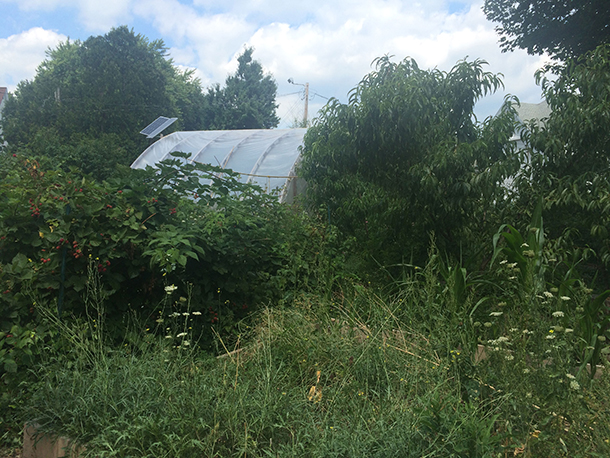
Eric’s garden features a greenhouse for indoor growing. (Photo: Jenni Doering)
Carbon farming describes the agricultural practices that bank carbon in the soil and biomass of farmed crops, and thus blunt global warming. Backyard farmer Eric Toensmeier is trying these methods in his own garden, trying to store as much carbon in his earth as gardeners more easily achieve in warmer climates. Living On Earth’s Helen Palmer took a tour of Eric’s home garden in Holyoke, Massachusetts for a crash course on growing perennial plants in temperate climates.
Transcript
CURWOOD: It’s Living on Earth, I’m Steve Curwood. As the concern about rising CO2 turns to alarm in places, experts are studying possible ways we might reduce it in the atmosphere. Several countries are looking to agriculture and farms and forests as part of the answer. Now, a large and comprehensive book, "The Carbon-Farming Solution" probes and analyzes the potential of perennial crops and agro-forestry to sequester carbon from the atmosphere. Its author, Eric Toensmeier is using his own garden in Holyoke, Massachusetts, as a demonstration of what can be done, even with just a tenth of an acre of land. Living on Earth’s Helen Palmer paid Eric a visit to find out all about it.
PALMER: The first hint you get that there’s a mystery behind Eric Toensmeier’s stucco covered house when you drive up there are the large lush leaves of an eight-foot banana plant in the front yard – unusual for suburban New England. But it shows what carbon farming means, agriculture to remove excess carbon from the air and soil and store it in trees and plants. It’s a form of permaculture, mirroring natural and traditional systems that enhance and nurture the earth.
TOENSMEIER: None of these techniques were developed for the purpose of sequestering carbon.
[BACKGROUND SOUNDS OF CHILDREN PLAYING AND OTHER ACTIVITIES]
They were all designed because they do something important on the farm. So increasing organic matter in the soil is already a good idea on the farm, incorporating trees in the right way and in the right context can increase the productivity of the farm quite a bit. Studies in France have found, for example, that when you combine annual grain crops with timber trees and you have the spacing right, on 100 acres you could produce the same amount of grain and timber that would take 130 to 140 acres to produce if they were grown on their own.
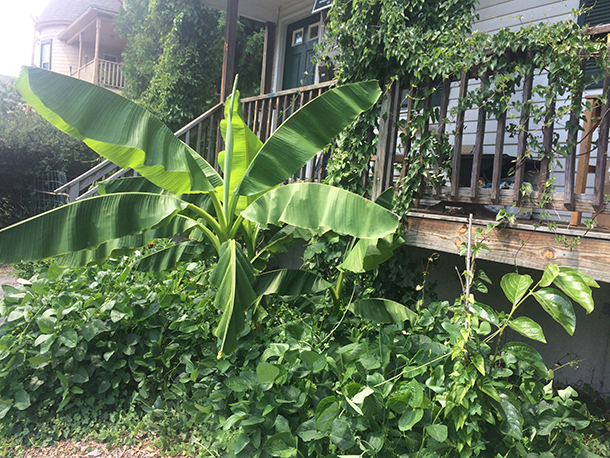
A banana tree sprouts from Eric’s front yard. (Photo: Jaime Kaiser)
PALMER: Those of us who live in cold climates with a small backyard find practices like inter-planting woody trees and grain crops foreign, and, geographically speaking, they are. The most successful and efficient carbon-sequestering farms and gardens are in humid and tropical climates, such as India, parts of Africa, Latin America and the Caribbean.
TOENSMEIER: My wife’s family has one in Guatemala and it’s the most unremarkable thing there, but I could go and get a PhD walking around in there because it’s so fascinating. Their multi-strata agro-forestry system with multiple layers of trees and shrubs and vines and herbs is the very best system for sequestering carbon that we have agriculturally. In fact some studies have found certain instances where tropical home gardens actually sequester more carbon than natural forests nearby. So, they can be very powerful, and yet we don’t have a lot of commercial models yet in cold climates, and so that’s been a lot of my work the past 25 years.
PALMER: Large-scale commercial agriculture in much of the world and certainly in the U.S. features annual, often commodity crops that depend on widespread use of chemicals. Think corn and soy beans, though it can also mean apple and almond orchards. And it produces a lot of food.
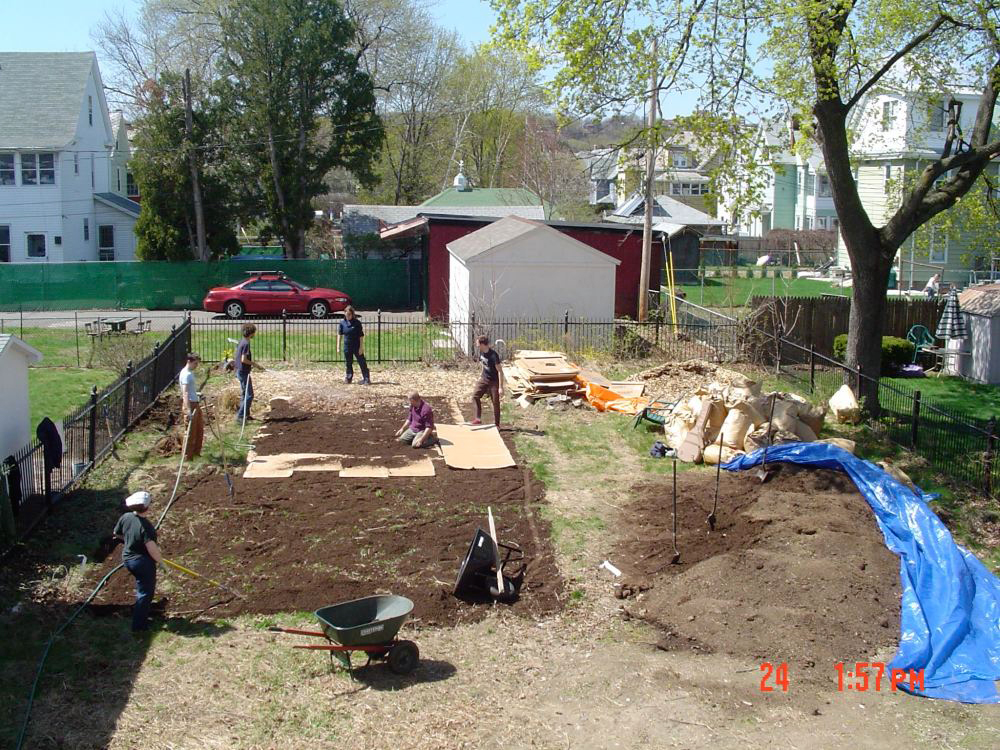
Eric nurtured his garden from a bare plot of land. (Photo: Eric Toensmeier)
TOENSMEIER: Productivity per acre is very high and that’s great because that allows us to minimize deforestation to clear land for more agriculture. And many would argue that more fertilizer and pesticides would help us do that. My personal approach that I advocate in the book is that there are agro-ecological practices that also intensify, grow more on the same land, without increasing those less environmentally friendly aspects of agriculture as we know it today.
PALMER: One traditional practice Eric is using here is growing perennial plants. Plants that last more than one growing season, and he often uses edibles you can’t find in seed company catalogues. But in the United States, the yields of perennials can’t compete with annuals yet, so his garden is a kind of informal research project where he’s out to match the carbon-capture potential of the home gardens in the tropics.
TOENSMEIER: Mostly perennial crops are not really interesting to big seed companies, partly because perennials, once you buy the seed, you don’t have to go back and do it again so it’s not their priority, and big seed companies aren’t working on developing perennial kale, let’s just say.
PALMER: [LAUGHS] Well we should go and have a look at your plot. You are demonstrating some of these potential ways of carbon farming in your own backyard.
TOENSMEIER: Great.
PALMER: I follow Eric behind his greenhouse first, through a green tunnel of tall shrubs and fragrant flowering plants.
TOENSMEIER: This is a little patch that has some plants that attract beneficial insects. These are mountain mint, which is a native one, and there’s a large, nitrogen-fixing shrub, false indigo, which is being used as a trellis for perennial, edible beans which are not yet ready for prime-time. They need some breeding work. There’s great perennial beans in the tropics and even in warm, temperate, or Mediterranean climates, but here we still need some work to be done.
PALMER: I’d never heard of perennial beans but this one is hardly new. Eric has the scientific name.
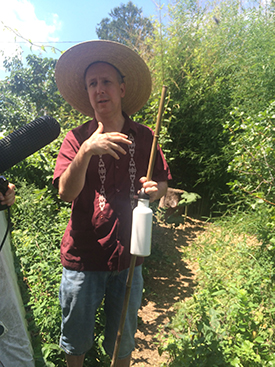
Eric has dedicated his career to advancing carbon-capturing, agro-ecological practices in temperate food forests. (Photo: Jenni Doering)
TOENSMEIER: Phaseolus polystachios. That was actually cultivated historically by Native Americans throughout the east, and some Native folks definitely still definitely grow and use it today. The beans are pretty small. They’re maybe the size of a mung bean but people eat mung beans, and with some work it could really be developed into a very exciting new crop for this climate. And the shrub, as well, is one of the most widely used agro-forestry crops in China, even though it’s native here, and it’s used as pesticide, as fodder, and as an indigo dye, so it’s a very nice multipurpose species as well. It’s one of the best of our native species for agro-forestry.
PALMER: Well it’s interesting that you have beans because obviously beans are one of the three sisters - the corn, beans and the squashes - which the Native Americans grew, and they in fact grew the beans up their corn plants.
TOENSMEIER: And still do. We’re looking at a similar model. We’ve done some different trials here trying to replicate that particular corn, beans and squash with perennials, and we have not found the perfect match but this kind of system of a vine climbing on a nitrogen-fixing tree you see a lot throughout the tropics.
PALMER: This cohabitation is a recurring theme in Eric’s garden. It seems every crop has other plants with multiple uses growing around, above, and underneath.
TOENSMEIER: In these multi-strata systems, these food forest systems, we try and take advantage of all the space. So we ask ourselves, “What can we produce in the shade or in the partial shade beneath and between those trees?” In the tropics it’s things like coffee and cacao and vanilla or kava, tea, a lot of really wonderful crops. We don’t have anything quite that great here yet for really full shade, but we’re growing lots of perennial vegetables in the shade, culinary herbs, nitrogen-fixing plants, plants that attract beneficial insects, aggressive ground covers that serve as a living mulch.
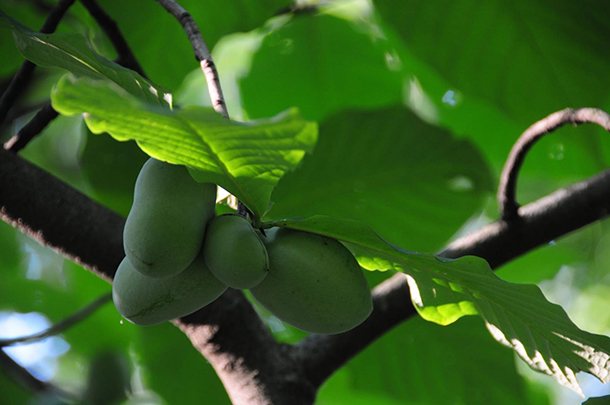
A North American Paw Paw tree bearing fruit. (Photo Jerry Edmundson, Flickr CC BY-NC-ND 2.0)
PALMER: A living mulch that can stop erosion, be turned into the soil to add structure and attract soil organisms like worms, nematodes, and bacteria to break it down. I follow Eric around to a mostly shaded patch of yard space along the side of his house, where he’s growing fruit trees.
TOENSMEIER: These are paw paw trees, not the Caribbean paw paw which is papaya but the native, eastern paw paw of the U.S and, I think, a tiny bit of Southern Canada. It’s in the same family as a lot of tropical fruits like soursop or custard apple, but it really is very happy with the cold here. It’s native up into Michigan, so it can certainly handle cold. It produces a very large fruit. It’s North America’s largest native, edible fruit, I’m told, and I did see one last year that was the size of a large mango. Typically ours are more like a medium-sized potato. They’re still young right now, still small right now. And the really nice thing about paw paw is it’s very happy with partial shade, so it may be like our cacao or coffee in that it could be a shade crop for us in a commercial multi-strata system. In fact, the few commercial producers of paw paw that are working in the US now are finding that they are very vulnerable to wind damage and that inter-planting trees actually makes you ripen more paw paws because it slows down the winds.
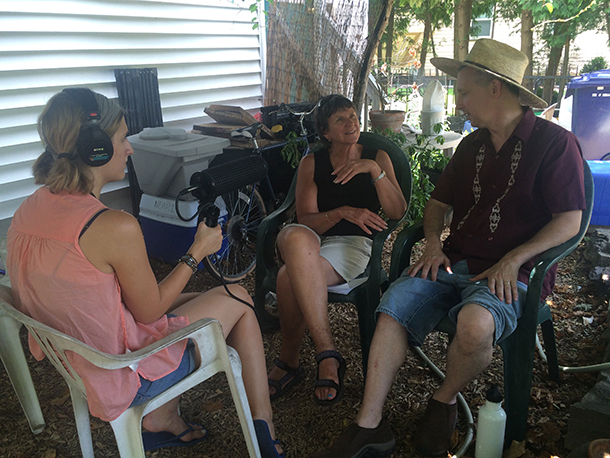
Recording in Eric’s backyard space. (Photo: Jenni Doering)
PALMER: Beneath the paw paws is a pile of twigs and branches and suckers cut away from the trees. Instead of removing them, Eric often leaves this organic matter to decompose right there on the ground.
TOENSMEIER: As that material breaks down, it turns into organic matter, so a high residue system like this is very, very good for carbon, and we’re seeing that a lot around the world. Like in Brazil, there’s a very exciting agro-forestry movement underfoot that is largely based on heavily pruning timber trees to put carbon back into degraded soils, so we do a lot of that here, and it is unsightly to the average gardener and it was unsightly to me for many years but I’ve come to think, “Well if the ground in my garden looks like the soil of a forest, then I’m on the right track”.
PALMER: Eric leads me to the back of the garde, conveniently screened by a 12 foot bamboo grove whispering in the breeze. He uses bamboo for just about everything.
TOENSMEIER: This one we absolutely love. It’s just such a useful product for us to have in the garden for trellising, for staking things. Almost every challenge we have, we use bamboo. When our fruit branches are so heavy with fruit that they want to break, we cut some bamboo and put it on there to prop it up. So it’s listed as having about 1,500 uses. One of the challenges is that it often doesn’t fit into the climate finance system we have because it’s not properly a tree. It’s a giant grass so a lot of these fall between the cracks in national agencies because they’re maybe not really forestry and not really agriculture.
PALMER: How many different species are you growing here do you think?
TOENSMEIER: We’re growing about 300 species of useful perennials. Maybe 70 or 80 of those are woody plants, which would be trees or shrubs or bamboos. We have about 80 species with edible leaves, perennials with edible leaves, about 50 perennials with edible fruit, and then a whole diversity of other things, and then we grow a whole bunch of annuals too and different kinds of micro-livestock as well and some kinds of fungi that we cultivate. So it’s very diverse, and, although it’s a crazy level of diversity for a farm, for a very small garden, it’s fun if that’s what you’re into.
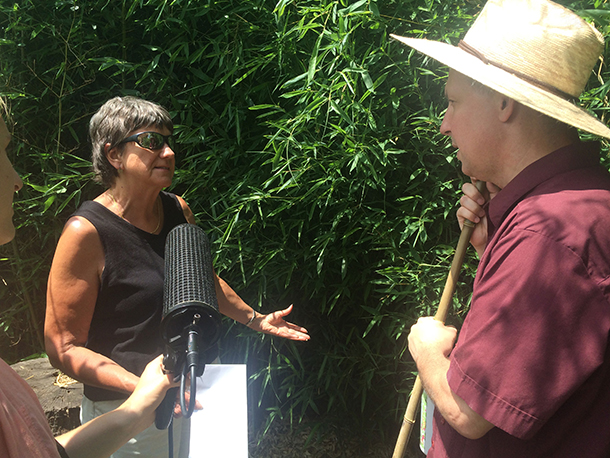
Bamboo has over 1,500 practical applications. (Photo: Jenni Doering)
PALMER: Over alongside the neighbor’s fence, Eric grows fruit bushes, some familiar, like raspberries, Asian pears, and blueberries, and some more unexpected...
TOENSEMIER: And if we turn and face the other way we have a young persimmon that’ll eventually fill in this area and then a chestnut and then a mulberry, so we’re really looking beyond the north edge of building out this very fruit and nut type forest. And we have some trees with edible leaves that we’re very excited about, and we’re starting to move those around the garden more and more as well.
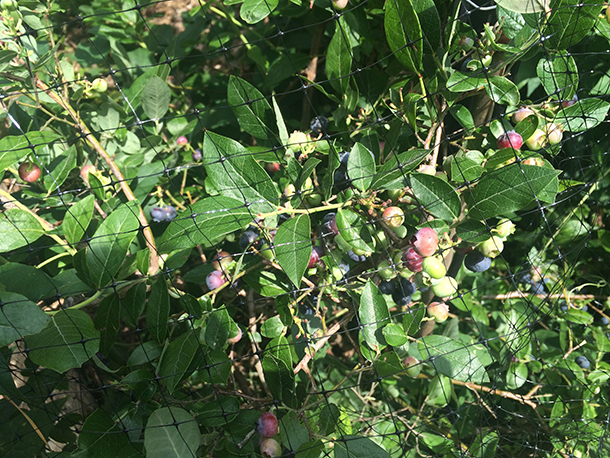
Eric considers berries “the gateway drug to perennialization.” (Photo: Eric Toensmeier)
PALMER: Trees with edible leaves...Now are you going to eat these?
TOENSMEIER: We eat them now! In fact the main problem is that we’re eating them so much so much that they’re not growing well enough, and we need to lay off of them for a little bit.
PALMER: Eric has calculated that his garden makes its own small but noble contribution to addressing the carbon crisis.
TOENSMEIER: We ran numbers at one point on our backyard and figured that the carbon sequestration happening here in this tenth of an acre offsets the emissions, roughly speaking, the emissions of one American adult in one year. So certainly the scale at which we’re doing this is not the scale which is necessary to fully address the problem, but it’s sort of a research and development project, and it’s certainly doing more than mowing a lawn. It’s a step in the right direction.
PALMER: Which direction should we step in now? Eric heads over to what he described as the carbon-sequestering food of the future.
TOENSMEIER: This is a bush clover that grows about nine or 10 feet high here. It’s a marvelous feed for livestock, it’s a commonly used agro forestry species in Asia, and you can make leaf protein concentrate out of it.
PALMER: Yes, Eric believes our children and grandchildren could be, and maybe should be, eating leaf-concentrate steaks. There’s a whole class of these grasses that you can extract protein from, and some yield a concentrate that’s as much as 50 percent protein on a dry-weight basis.
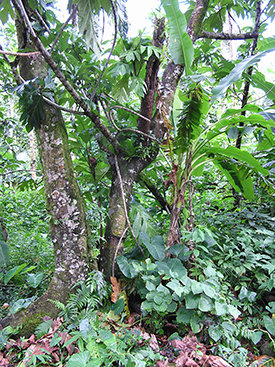
The practice of inter-planting crops is demonstrated by this patch in the Island of Pohnpei. (Scott Nelson, Flickr CC BY-NC-SA 2.0)
TOENSMEIER: So by switching to these giant grasses you can produce protein and energy on the same land while sequestering carbon in the soil. So there are a lot of these very new, interesting things emerging, and the proposal is to feed that protein to livestock. I would argue you can also feed it to people, as someone who eats it myself. But the productivity on a per acre basis of protein with leaf protein concentrate is about 30 times more than beef. So there are a lot of interesting places we can go. I like beef! I think it’s delicious but...
PALMER: You don’t have hamburger every day.
TOENSMEIER I don’t have hamburger every day, and I don’t really think, unless maybe you live in Wyoming or Montana where grazing is the most appropriate use of the land, farming-wise in some places, I don’t think we’re all going to be eating three steaks a day, and that’s how we’re going to get climate change mitigation.
PALMER: But in spite of all the novel ways Eric’s trying to help, he admits that carbon agriculture has its problems.
TOENSMEIER: There’s a limit to how much carbon you can store in soil and biomass, and experts estimate that that’s somewhere around 200 billion tons globally. So, in other words a soil fills with organic matter to a certain point, and then it’s, they say, “saturated.” It’s more or less filled up, and a forest will rapidly sequester carbon when it’s young, but, when it starts to fill in, it’s full, and it’s not going to put it on at a very rapid rate anymore.
PALMER: That's, that’s actually a little daunting, the fact that we cannot sequester all the carbon we need to, to actually reduce the parts per million of CO2 to the 350, the famous 350.
TOENSMEIER: If we did it now and ceased all emissions today we could. So, given that all emissions are not going to stop this year, we need to look for more and more aggressive ways to sequester carbon on farms.
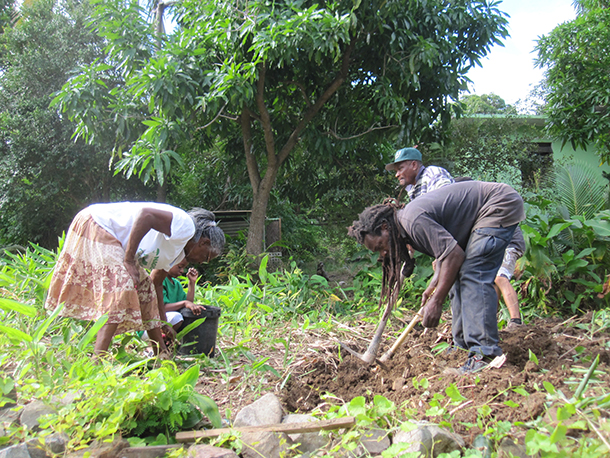
Digging arrowroots in a home garden in St. Martin. (Photo: Eric Toensmeier)
PALMER: How receptive are farmers in general to this kind of idea, to this kind of shift of the way they work?
TOENSMEIER: Well, in the United States a lot of our farmers are very grumpy about climate change and don’t think it’s a real thing at all, but, when you talk about the particular practices, many of them are very excited about them and want to do them. Certainly many of our farmers obviously both believe in climate change and are enthusiastic about trying to mitigate it on the farm, but not all of them are.
The barrier is that, to make a transition on your farm, even if you’re, let’s say, just changing from conventional to organic, let alone bringing in an agro-forestry system, is you’re looking at a two to five year period where you’re losing money, and most farmers are not operating in a way that they can do that. So that’s where the need for finance comes in, and we see all these people divesting from fossil fuels. We’d like to see a robust financing system, so they can invest that money in carbon farming. It goes out to farmers to make these transitions, to get over that two to five year hump, and it’s not like we need to pay farmers every year forever to do this. We just need to help them make the transition because again most of these practices increase production on the farm.
PALMER: Before I leave, I ask Eric if he has any advice for home gardeners like me who want to sequester more carbon in their patch.
TOENSMEIER: Well, the first thing is growing any of your own food at all is reducing emissions for transportation, and anything you can do to reduce tillage, to have a no-till system, a heavy mulch system, is going to be excellent. Any of your own composting you can do is going to be excellent; you’re starting to bank some of that carbon in your soil organic matter, and the more you can perennialize the better.
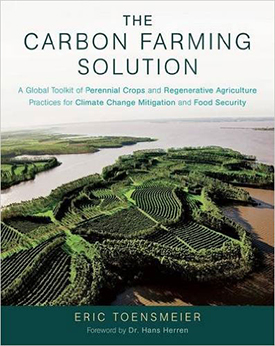
The Carbon Farming Solution offers all the details into this one branch of Permaculture. (Photo: Chelsea Green Publishing)
And I feel like the gateway drug to perennialization is berries. Everybody like berries. Berries are delicious. They’re really good for you. Most of them are pretty easy to grow, and in this climate we have some good options for at least partial shade and a few for full shade. And that’s where I would have people start.
PALMER: And that way they can be part of the carbon farming solution?
TOENSMEIER: Absolutely, absolutely. If all of us did this in our gardens it wouldn’t be enough to do the trick, but it would be a huge contribution.
PALMER: I’m sold, and not only because the bounty of Eric Toensmeier’s backyard is such an inspiration and a rebuke to less competent, more scattershot gardeners like me. It’s also because, if we believe the climate’s changing, and the way we live here in the more developed part of the world is making thing things worse, then working to fix the problem in whatever way we can is surely also our responsibility. And how wonderful that something as joyful and satisfying as growing your own food can be part of the answer. For Living On Earth, I’m Helen Palmer Holyoke, Massachusetts
Links
The Carbon Farming Solution book
Living on Earth wants to hear from you!
Living on Earth
62 Calef Highway, Suite 212
Lee, NH 03861
Telephone: 617-287-4121
E-mail: comments@loe.org
Newsletter [Click here]
Donate to Living on Earth!
Living on Earth is an independent media program and relies entirely on contributions from listeners and institutions supporting public service. Please donate now to preserve an independent environmental voice.
NewsletterLiving on Earth offers a weekly delivery of the show's rundown to your mailbox. Sign up for our newsletter today!
 Sailors For The Sea: Be the change you want to sea.
Sailors For The Sea: Be the change you want to sea.
 The Grantham Foundation for the Protection of the Environment: Committed to protecting and improving the health of the global environment.
The Grantham Foundation for the Protection of the Environment: Committed to protecting and improving the health of the global environment.
 Contribute to Living on Earth and receive, as our gift to you, an archival print of one of Mark Seth Lender's extraordinary wildlife photographs. Follow the link to see Mark's current collection of photographs.
Contribute to Living on Earth and receive, as our gift to you, an archival print of one of Mark Seth Lender's extraordinary wildlife photographs. Follow the link to see Mark's current collection of photographs.
 Buy a signed copy of Mark Seth Lender's book Smeagull the Seagull & support Living on Earth
Buy a signed copy of Mark Seth Lender's book Smeagull the Seagull & support Living on Earth

